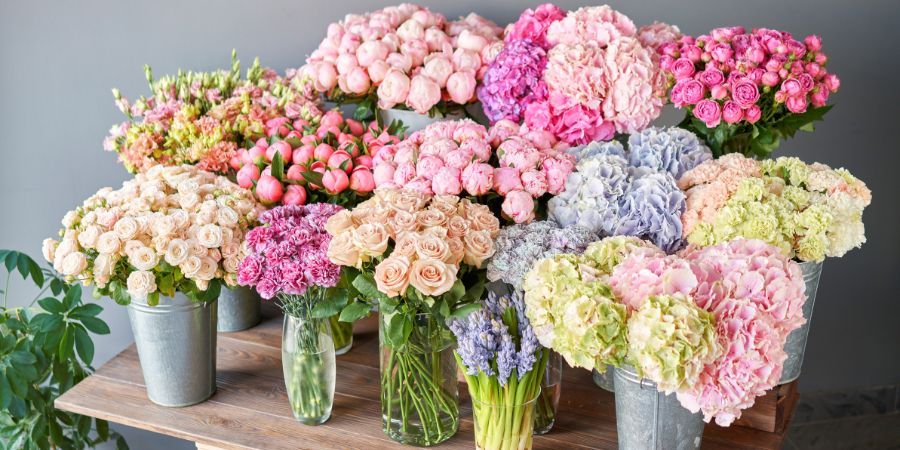
Floral Design, General Tips, Your Event Career
A Day in The Life of a Florist
Updated 2025.
Key Points
- A florist is a person who sells flowers and floral arrangements.
- Florists can work in a variety of settings, including grocery stores, flower shops, from home, and even online.
- In addition to creating arrangements, florists may also be responsible for: watering plants, trimming stems, delivering orders, and keeping the work area clean and organized.
- If you run your own floral design business, you’ll also be responsible for all business-related daily tasks as well.
- While many florists do have regular daytime hours, some may also have to work evenings and weekends. Holidays will always be an especially busy time for florists.
- In the United States, florists can expect to make anywhere from USD $22,500 – $45,000 per year.
- That said, your income can be much higher than this depending on your experience, services, prices, marketing, etc.
- Pros of working as a florist include: being very rewarding, getting to work with beautiful flowers, helping people celebrating special milestones/events, you can be your own boss, and you can make a great income.
- Cons include: it can be stressful (particularly during the holidays), requires both physical dexterity and artistic ability, and may involve working long hours sometimes.
- While you don’t technically need a formal education to become a florist, it’s strongly recommended.
- QC Event School offers a self-paced, online Floral Design certification course. This program can be completed in as little as 12 weeks and will provide the graduate with a globally-recognized International Floral Design Professional (IFDP)™ certification upon completion.
- QC Event School has helped over 30,000+ students and grads launch successful careers in the events and wedding industry.
- The 3:5-8 rule is a common guideline used by florists for creating balanced and visually appealing floral arrangements, which recommends using: three different types of flowers, five stems of each type, and arranging them in groups of 8.
- The golden ratio suggests that objects should be arranged in a roughly 1:1.618 ratio – and in floristry, this can be applied when choosing the height and width proportions of an arrangement or when arranging multiple flowers together.
- In floristry, the golden rule of flowers is to always start with a good foundation, which means: properly preparing the stems, choosing complementary colors and textures, and arranging the flowers in a balanced and visually appealing manner.
Introduction
Many people look at florists and think, “Oh, that’s so pretty!” But they don’t actually realize the amount of hard work that goes into making those beautiful arrangements. A day in the life of a florist is far from easy – but it’s definitely rewarding!
In this article, we’ll give you a crash course on what working as a floral designer is truly like. This way, you’ll be able to confidently say whether this type of job is right for you or not. So, are you thinking about becoming a floral designer? Do you just want to learn more about this fascinating profession?
Keep reading to learn what a day in the life of a florist is really like!

What is a Florist?
A florist is a person who sells flowers and floral arrangements. Florists can work in a variety of settings, including:
- Grocery stores;
- Flower shops;
- From home;
- And even online!
What is a Typical Day for a Florist?
The main job of a florist is to create beautiful arrangements out of fresh flowers. This involves skillfully selecting the right type and amount of each flower, then arranging them in a way that is both aesthetically pleasing and structurally sound.
Florists must also have excellent customer service skills, as they’ll often be working closely with customers to ensure that they are happy with their final product. In addition to creating arrangements, florists may also be responsible for:
- Watering plants;
- Trimming stems;
- Delivering orders;
- And keeping the work area clean and organized.
A Day in The Life of a Floral Designer: What are The Hours Like?
The hours of a florist can be very demanding, especially during busy periods like Valentine’s Day, Mother’s Day, and Christmas. Florists often have to work long hours, and may even have to be on call in case of last-minute orders. While many florists do have regular daytime hours, some may also have to work evenings and weekends. This is especially true for those who work in flower shops or grocery stores, or run their own floral design business.
Can You Make a Living Being a Florist?
In terms of salary expectations, there’s no clear-cut answer to this question. Your income will vary depending on your:
- Experience level;
- Location;
- Service demand;
- Target demographic;
- Marketing strategies;
- Service rates;
- Whether you’re self-employed or work for someone else, etc.
With this in mind, we can still give you a general idea of how much you could potentially make per year – depending on the country you live in. Here are some annual salary ranges, based on a handful of example countries:
- United States: Between approx. USD $22,500 – $45,000 per year
- Canada: Between approx. CAD $33,000 – $43,000 per year
- United Kingdom: Between approx. GBP £23,660 – £33,280 per year
- New Zealand: Between approx. NZD $48,151 – $75,000 per year
- Australia: Between approx. AUD $65,000 – $75,000 per year
- Nigeria: Between approx. NGN ₦680,100 – ₦2,352,500 per year.
Become a professionally-trained, globally-certified International Floral Design Professional (IFDP)™ in as little as 3 months. Enroll in QC Event School’s self-paced, online Floral Design Course today!

How Stressful Is Being a Florist?
Like with most jobs, working as a florist can be stressful at times. This is especially true during busy periods, when you might have to deal with cranky customers, long hours, and tight deadlines. That being said, many people find the job to be very rewarding – even in the midst of all the stress! If you’re passionate about flowers and enjoy working with your hands, then a career in floristry could be a great fit for you.
How to Become a Florist with No Experience
Interested in becoming a florist, but have no prior experience? Don’t worry, you can still make it happen!
One of the best ways to get started is by taking a certification course in floral design – such as the self-paced, online Floral Design Course offered by QC Event School. This training program will give you a thorough understanding of all the various skills and techniques needed to be successful in this field long-term!
Once you’ve completed your QC course and are properly qualified as an International Floral Design Professional (IFDP)™, you should then start looking for internships or apprenticeships with local florists. This is a great way to gain some real-world experience, and learn from experienced professionals. Moreover, you can also look into volunteering with organizations that deal with flowers – such as hospitals, nursing homes, or your local botanical garden. Not only will this give you some valuable experience; it’ll also help you make some important industry contacts.
No matter what route you decide to take, just remember that it takes time, patience, and a whole lot of hard work to become a successful florist. But if you’re up for the challenge, then a career in floristry could be very rewarding – both personally AND financially!
Speaking of Schooling, Do You Need a Degree to Be a Florist?
This is a common question, and the answer is no – at least not in most cases. In general, you do not need a college degree to become a florist. However, there are some instances where having a degree (or some form of post-secondary education) might give you an advantage. For example: if you’re looking to open your own floral design business, then a business-related degree could certainly come in handy.
Additionally, many larger companies or high-end hotels/resorts might prefer to hire candidates who have completed a formal training program in floral design – such as the one offered by QC Event School that we mentioned above.
At the end of the day, it’s really up to you whether or not you want to get a degree. However, if you’re truly passionate about this career path and want the best possible chances of success, getting some form of reputable qualification training is strongly recommend. Firstly, being properly certified will give you an edge over the competition and attract more clients. Secondly, it will also help to boost your confidence and give you the skillset needed to excel in this exciting field!
Pro Tip: Interested in learning even more about how to become a florist – even if you have no previous experience? Our Ultimate Guide will break down everything you need to know in 10 easy steps.
Working as a Florist: Pros and Cons
Pros:
- Can be very rewarding, both personally and financially.
- You get to work with beautiful flowers every day.
- Helps people celebrate important life events/milestones.
- You can be your own boss (if you decide to open your own business).
- Relatively easy to get started in (no formal education required in most cases).
Cons:
- Can be stressful, especially during busy periods.
- Requires physical dexterity and artistic ability.
- May involve working long hours, including weekends and holidays.
All in all, being a florist can be a very rewarding career – both emotionally and financially. However, it’s important to keep in mind that it also has its challenges. If you’re up for the task and willing to put in the hard work, then a career in floristry sounds like it’s right up your alley.
QC Event School has helped over 30,000+ students and grads launch thriving careers in the events and wedding industry. Read some of their success stories!

A Day in The Life of a Florist
As a florist, it’s important to know that no two days are ever the same. That said, there are some general tasks that you can expect to perform on a regular, day-to-day basis. These include:
- Working with customers to choose the right flowers for their needs;
- Arranging flowers in vases or other containers;
- Delivering arrangements to customers;
- Taking care of plants and flowers in the shop;
- Selling floral supplies such as vases, potting soil, etc.
In addition to these day-to-day tasks, you’ll also need to keep up with some general maintenance duties (such as watering plants, trimming stems, and keeping the shop clean). Depending on your location and clientele, you may also be responsible for setting up and breaking down floral displays for events such as weddings or funerals.
Running Your Own Floral Design Business
Furthermore, if you choose to launch your own floristry company, there are additional tasks you’ll have to take care of on a regular basis that tend to the business side of things. Necessary business-related duties will often include:
- Bookkeeping and accounting;
- Ordering flowers and supplies from wholesalers;
- Marketing your business;
- Maintaining your website and social media accounts;
- Hiring and managing employees;
- Networking, attending events, etc.
Of course, the list of potential responsibilities is endless – but these are just some of the most common duties you can expect to find yourself taking care of a business owner. Ultimately, no matter what tasks you’re responsible for on any given day, one thing’s for sure: working as a florist is NEVER dull! If you’re looking for a career that’s both creative and challenging, then this is the perfect path for you.
Fun Fact: QC Event School alumnus and industry professional, Neena McConnell, has also shared what a typical day as a floral designer is like for her!
A Day In The Life Of a Florist FAQ
Q: What is the 3:5-8 rule in floristry?
A: The 3:5-8 rule is a common guideline used by florists for creating balanced and visually appealing floral arrangements. It recommends using three different types of flowers, five stems of each type, and arranging them in groups of 8.
Q: How do I know which flowers to use in an arrangement?
A: Choosing the right flowers for an arrangement largely depends on the occasion, personal preference, and seasonality. As a florist, it’s important to have a good understanding of different flower varieties and their meanings so you can make informed decisions for your clients.
Q: What is the hardest part of being a florist?
A: The hardest part of being a florist can vary for each person, but common challenges include:
- Managing physical demands (such as long hours on your feet);
- Dealing with difficult clients;
- And keeping up with the fast-paced nature of the industry.
However, many florists also find these challenges to be rewarding as they hone their skills and learn to overcome them!
Q: What are some tips to help clients make a floral arrangements on a budget?
A: Some tips for creating budget-friendly floral arrangements include using seasonal flowers, opting for smaller bouquets or centerpieces, and incorporating greenery or filler flowers to make the arrangement appear fuller. It’s also helpful to discuss a client’s budget beforehand and offer alternative options that can meet their needs while staying within their budget.
Q: What is the golden ratio in floristry?
A: The golden ratio is a mathematical principle used in art and design, including floristry. It is often considered visually pleasing and suggests that objects should be arranged in a roughly 1:1.618 ratio. In floristry, this can be applied when choosing the height and width proportions of an arrangement or when arranging multiple flowers together.
Q: What is the golden rule of flowers?
A: The golden rule of flowers is to always start with a good foundation. Following this rule ensures that your arrangements are both beautiful and long-lasting for your clients to enjoy. This means:
- Properly preparing the stems;
- Choosing complementary colors and textures;
- And arranging the flowers in a balanced and visually appealing manner.
Conclusion
So, there you have it – everything you need to know about what it’s like to be a florist. We hope this article has given you some insights into this exciting career field and helped you to determine whether or not it’s the right path for you.
Got any questions or comments? Leave them down below. Thanks for reading!
